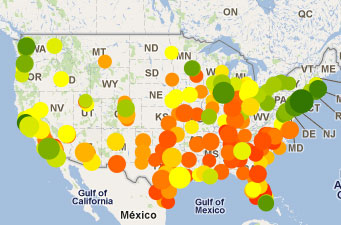My heroes at WalkScore are out today with updated walkability rankings for American cities. Using the new 2010 Census data and enlarging their analysis to include 2,500 cities, WalkScore’s new analysis includes some changes from last time around in 2008.
Here are the top 10 big cities for walking. There are some changes from last time around: New York nudged San Francisco out of the top spot; Seattle stuck to the number 6 position with a score of 73.7 (just behind Philadelphia and just ahead of DC); but Portland fell out of the top 10 to the 12th spot with a score of 66.3 (between Long Beach and Los Angeles).
The most walkable neighborhood in the Northwest? It’s no longer Portland’s Pearl District. It’s Seattle’s Denny Triangle with a neighborhood average score of 98 (though it’s worth noting that even the Denny Triangle is only 31st best in the nation). South Lake Union and Belltown were close behind with scores of 97. Portland’s most walkable neighborhood is its downtown, with a score of 96, followed closely by Hollywood and the Pearl District, each at 95. The best walking neighborhoods in the country are here.
Other notable cities in Washington include Tacoma and Kirkland, which tied for second in the Evergreen State with average scores of 59, and Shoreline with a score of 58. Among Oregon’s smaller cities, Ashland netted an impressive 62, Milwaukie scored 59, and Roseburg and Oak Grove both scored 58. Idaho’s most walkable city, Boise, earns a 50.
The full geekery/methodology is here.


Comments are closed.